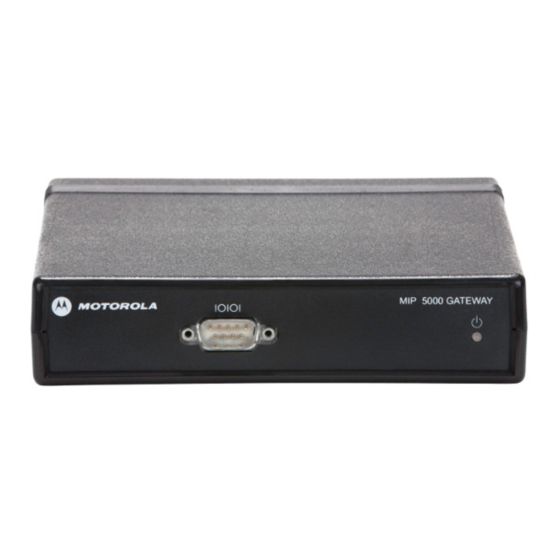Motorola MIP 5000 Quick Installation Manual - Page 4
Browse online or download pdf Quick Installation Manual for Radio Motorola MIP 5000. Motorola MIP 5000 6 pages. Voip radio console

Step 3. System Configuration
1. Use the CSDM to configure the system.
•
Select Configuration > System > Parameters and enter a Console Configuration Password
!
!
•
Important: Set Multicast Time-to-Live (TTL) equal to the number of subnet routers + 1.
•
Select Configuration > Console > Parameters to add a Console for each console in
the system.
•
•
Select Configuration > Radio Channel > Parameters to add a Radio Channel for each
MIP 5000 Gateway in the system.
•
•
2. Use the CSDM to save the database, then generate the configuration files for the MIP 5000 system.
•
!
!
Important: The configuration files must be generated before you can start the MIP 5000 VoIP Radio
Console program.
Step 4. Gateway Preparation
1. Open each Local or Tone MIP 5000 Gateway box that needs to have jumpers set to support a required
feature. Set the jumpers as required using the following tables. Do not remove jumpers S1 or S18.
•
•
Tone Control MIP 5000 Gateway
Features
Jumpers
S4
S12
*
PTT Relay
--
IN
†
*
Encryption
--
IN
‡
COR Detect
--
--
‡
High Speed Mute
--
--
†
Takeover
--
--
LOBL
IN
--
*
Repeat
--
IN
**
Leased Line
OUT
OUT
**
Leased Line with
OUT
OUT
Takeover
2. For each MIP 5000 Gateway:
•
Use null modem cable (
•
Establish a puTTY serial session (Start > Programs > Motorola > MIP 5000 > puTTY SSH Client)
on COM1 with 57,600 bps, 8 data bits, no parity, 1 stop bit. and no flow control.
•
Use the Gateway Main Menu to set the initial configuration parameters:
•
•
•
•
•
3. Secure each MIP 5000 Gateway unit into its permanent position.
TIP: Write down and save gateway serial numbers now in case you need Motorola service support later.
4. Connect the MIP 5000 Gateway units to the network using the Ethernet port (
5. Interrupt the power to the gateway after connection to the network to force a database upload.
6. Connect the radio equipment to the MIP 5000 Gateway units using the Radio port (
Enter MAC Address and Host Name or IP Address for each console, as recorded on the
Discovery Form at Step 1, Task 5.
Enter MAC Address and Host Name or IP Address for each gateway, as recorded on the
Discovery Form at Step 1, Task 4.
Select Radio Channel features as required, especially features related to jumper settings for
Local and Tone models. See the I/O area of the Radio Channel > Parameters, General tab.
Select Options > Generate Configuration Files and click Generate.
Tone defaults:
S4, S12, S13, S14, S17, and S18 are IN; S15, S16 are OUT
Local defaults: S7, S8, S10, and S12 are IN.
S13
S14
S15
S16
S17
--
IN
OUT
OUT
--
IN
IN
OUT
OUT
IN
--
--
OUT
OUT
IN
--
--
OUT
OUT
IN
OUT
OUT
IN
IN
--
--
--
OUT
OUT
--
IN
IN
OUT
OUT
--
OUT
OUT
OUT
OUT
OUT
OUT
OUT
IN
IN
OUT
DDN8671
TFTP server address (Host Name or IP address of CSDM computer)
Time server address (Host Name or IP address of time server computer)
Gateway addressing type (if your network uses static IP addressing)
Gateway IP address (if your network uses static IP addressing)
Default Gateway IP address (if this gateway is in a different subnet than the consoles using it)
S18
Relay
Opto
Common
IN
(K3) Pin 7
Pin 1
--
(K1) Pin 8
Pin 2
Pin 1
--
Pin 2
--
Pin 2
J5 Pin 1 = Parallel Audio+
--
J5 Pin 8 = Parallel Audio–
IN
Pin 7
--
(K1) Pin 8
Pin 1
OUT
J5 Pin 1 = Parallel Audio+
OUT
J5 Pin 8 = Parallel Audio–
) to connect the gateway serial port (
Local Control MIP 5000 Gateway
Features
Jumpers
S7
16 Freq Encoded
IN
4 Freq Decoded
OUT
2 Freq
OUT
4 Private Lines
OUT
PTT Relay
--
Monitor
--
*
Puts the common pin to ground when IN.
†
Encryption & Takeover are mutually exclusive with all options
except PTT Relay (use S12 with internal ground) and LOBL.
‡
COR Detect & High Speed Mute are mutually exclusive.
**
On a leased line, the Tone Control gateway does not support
PTT Relay, Encryption, COR Detect, HSM, LOBL or Repeat.
) to a computer COM1 port
IOIOI
).
).
S8
S10
S12
IN
--
--
OUT
--
--
OUT
--
--
OUT
--
--
*
--
--
IN
*
--
IN
--
